Contents


Practically in every garden, radish is grown, at least some variety of this long-known and respected culture is present in our dachas, and therefore on the tables. It is with its health benefits that it attracts a summer resident, everyone knows the beneficial properties of white and black radish. Recently, less familiar types of radish have become popular – Japanese daikon and Chinese green (loba) or Margelan, which is also called Uzbek, because it came to us from China along the Silk Road, through the ancient city of Margilan, which still stands on the territory of modern Uzbekistan.
Features and benefits
Margelan radish is called the champion in the number of macro- and microelements needed by a person. It contains vitamins, sugars, pectin, fiber, essential oils, but it is from it that a person can get the maximum amount of elements needed by the body in the process of growth and functioning. In addition, the ability to stimulate appetite, speed up metabolism, cleanse the internal organs of sand and congestion make it even more desirable in our menu. The minimum amount of mustard oil explains the advantageous difference in its taste – green radish has almost no bitterness, it is sweet and juicy, goes well with other vegetables, so even the most capricious children eat it.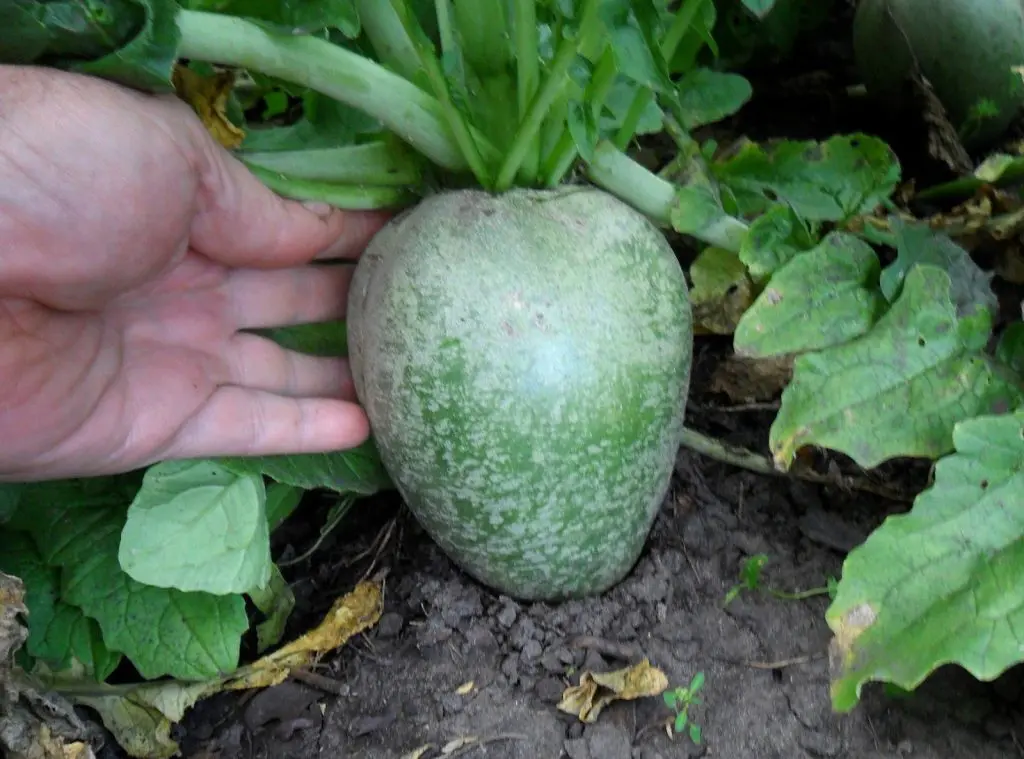
Traditional medicine has long used the specific features of radish, so Chinese is used as an anesthetic and antiseptic, in the fight against colds and flu. It is recommended for those who adhere to diets (therapeutic or for any reason), who have problems with the liver, impaired kidney or gallbladder function. It also helps people with reduced secretion of gastric juice.
The beneficial qualities of the Margelan radish can become dangerous for some people if consumed excessively. So, if there are stones in the internal organs, the radish juice can move them without having time to dissolve, so it is recommended to mix it with other juices (carrot, beet), and it is better to do this under the supervision of a doctor.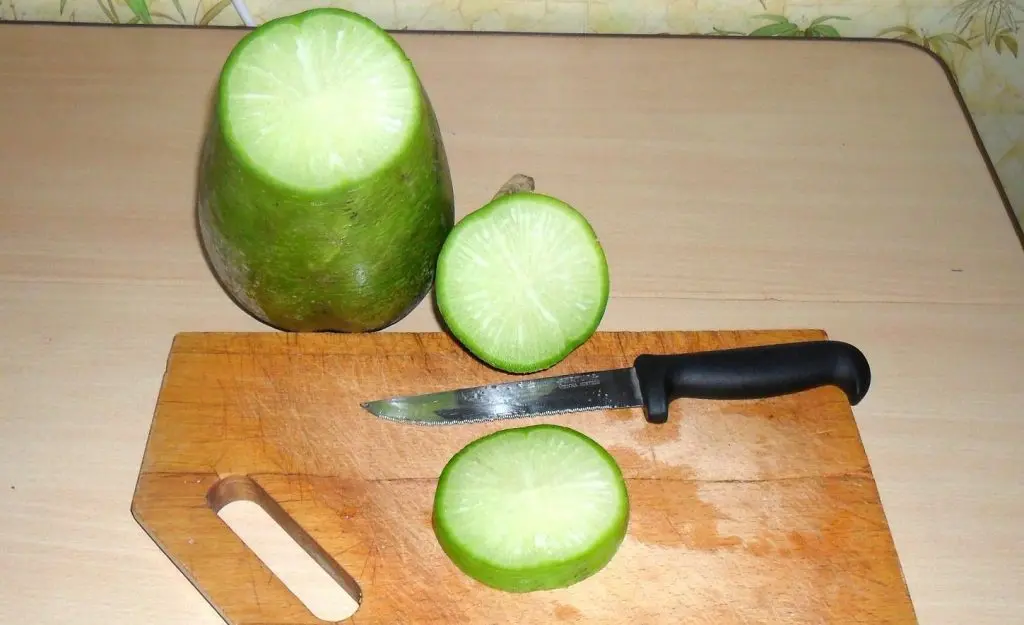
Fascination with radishes during pregnancy can tone the uterus. And at the time of exacerbation of stomach diseases, even the most harmless salad will provoke discomfort. You just need to be reasonable and careful, because only useless food does no harm.
Margelan radish is the most diverse type of radish according to external data. Its roots can be white, green, red or purple on the outside, but the upper part under the tops is always green, even not only white, but light green, cream, pink and even red. Watermelon varieties are gaining more and more popularity, in which round, green roots on the outside in the section delight with red pulp. Even the shape and size can surprise – round, cylindrical and simply elongated root crops can grow from 300 grams to one and a half kilograms in weight.
Video “What is Margelan radish?”
In this video, experienced gardeners and gardeners will tell you what this vegetable is.
Growing rules
Margelan radish: planting and care, planting dates – everything is similar to other species, but it has some nuances that you should pay attention to in order not only to grow a rich crop, but to harvest it without the help of pests, and even save it for the winter. Radishes need to be watered, weeded, sometimes hilled and fed, protected from pests. It is very important that watering is regular – drought will make the root crop hard, and abundant watering after it can cause cracking.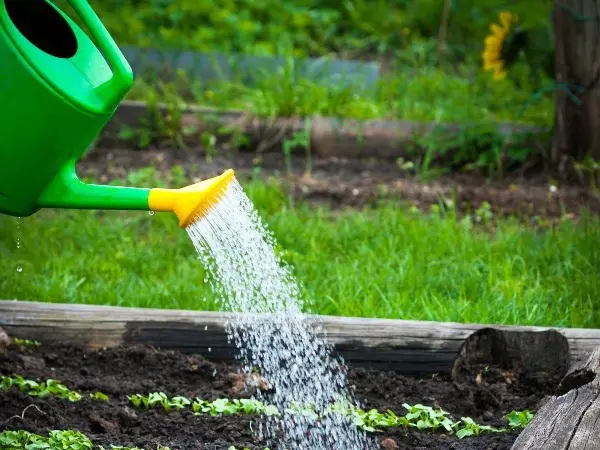
Soil preparation
Chinese radish is an undemanding plant, it can grow on any soil, but if a gardener wants to grow tasty, large, juicy root crops, then you need to create the best conditions for it. The soil should be fertile and non-acidic, but if you apply a lot of fertilizer, there will always be a risk that they will accumulate in the roots (especially nitrogen). Therefore, it is best to prepare the ground in advance: in the fall, the future bed needs to be dug up at least 30 cm deep, compost or humus is added to it, mineral fertilizers (superphosphate, ammonium sulphate and any potash) are added, wood ash. You can add peat or sand if the soil is very heavy, but the roots can grow even in clay. If the soil is acidic, then 2 or 3 weeks before that, it is advisable to add lime or dolomite flour, let it absorb.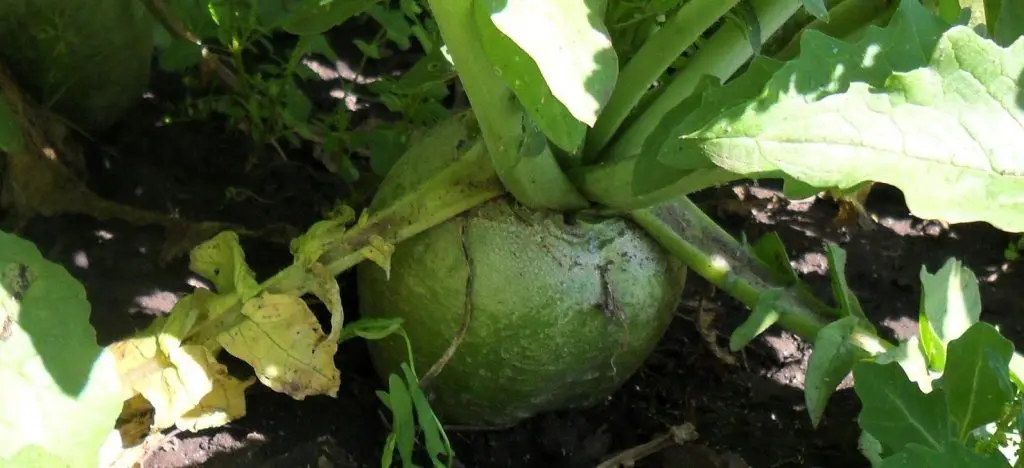
Radish should not be grown after its relatives (cabbage, radish, turnip) for 3-4 years, it will grow best after tomatoes, cucumbers, onions or potatoes. Under these vegetables, you need to fertilize the bed well, then the radish after them will get a perfectly enriched land. And fresh manure cannot be applied even in the fall before spring crops, the roots will be tasteless, hard and branchy, and there will be too much nitrogen.
Green radish grows well on raised beds, and in areas located in lowlands, it is imperative to raise the beds 15–20 cm above the general level of the garden. In the spring, before sowing, compost or humus is scattered around the site, then they dig up again, and grooves are marked.
Dates and methods of landing
Green radish can be grown twice in one season. In the spring, they are usually sown early, which is planned to be eaten fresh immediately. And in the fall, radishes are planted, which can be eaten immediately, but can be put in a cellar or basement for long-term storage. So in the spring they usually sow at the beginning of May, when it is already warm, and the crop is harvested at the end of June. The radish can perfectly survive the cold snap, even slight frosts, and the seeds will germinate at an air temperature of +3 or +5 degrees, but such conditions will not allow the root crop to grow, but will provoke rapid flowering. It should be planted so that growth does not fall on the longest daylight hours, and the air temperature remains between +18 and +22 degrees. If the temperature drops below +15 or rises above +25 degrees, then the plant forms a peduncle, which means that it will no longer fit for food, it will have to be thrown away or wait for seeds. This is what you need to focus on when determining the timing of sowing seeds in the ground, which means that these timings will be different for each locality. Someone else will sow in April, and someone else in mid-May.
Anyone who wants to eat radish in winter and immediately thinks about where and how to store it, sows late varieties in the first half of July. For most varieties, the technical maturity of root crops occurs 60-90 days after germination. When frosts come, every summer resident knows approximately. Here, based on these parameters, it is possible to determine the timing of summer sowing for each locality. In the south, they sow in August, and in the north they already harvest in September. In the second half of summer, the weather is usually not so hot, daylight hours are reduced, this reduces the possibility of shooting plants, if you take good care of it, you can think about how to store a large crop.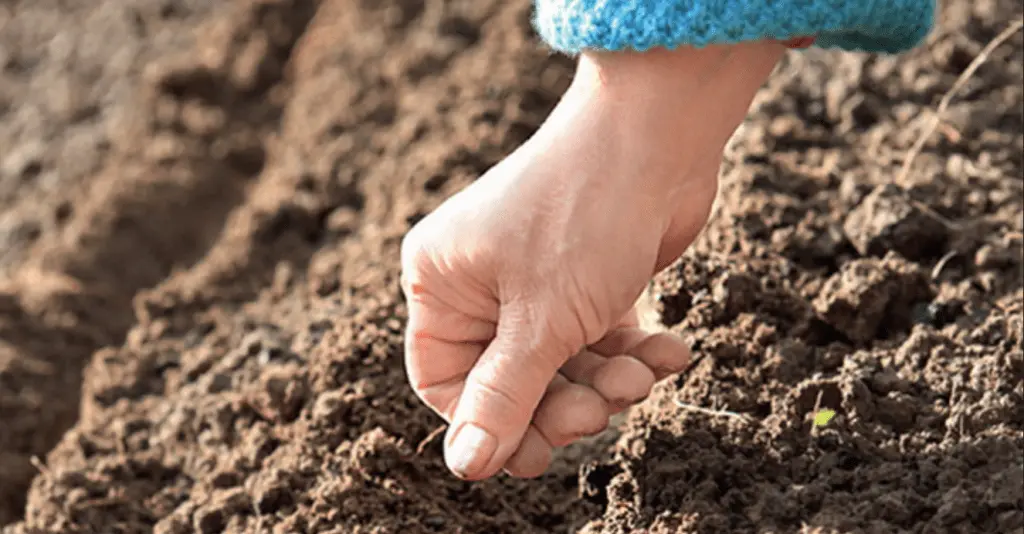
The radish grows large, it needs a lot of space, so it is sown, leaving at least 35 cm between rows. You can put 3 – 4 seeds in a row, and then the next portion after 15 cm. If you sow with the nest method, then 3 or 4 seeds should also be placed in each nest, and the nests should be staggered. Sowing is usually carried out in moist soil to a depth of 2 cm, then the seeds are covered, the soil is lightly tamped, and if necessary, watered a little more.
Many gardeners soak seeds before sowing, they germinate after about 5 days, dry seeds germinate a few days later. Experts recommend disinfecting planting material with a weak solution of potassium permanganate to reduce the possibility of diseases. Soaking will help to pre-sort completely empty specimens that will not sprout at all.
Thinning
Such sowing of several seeds together implies further thinning of seedlings. The first time this is done at the stage of the appearance of the second leaf – the weakest plant is plucked from the nest, and 15 cm (or even 18 cm for large-fruited varieties) are left in the row between small groups of 3 sprouts. When roots begin to form, remove all plants whose leaves have not turned true green. The crops are thinned out for the last time when the root crops have grown to 5 mm in diameter, one of the strongest plants is left in the nest, and in the row it is checked that 15–20 cm are left between the plants.
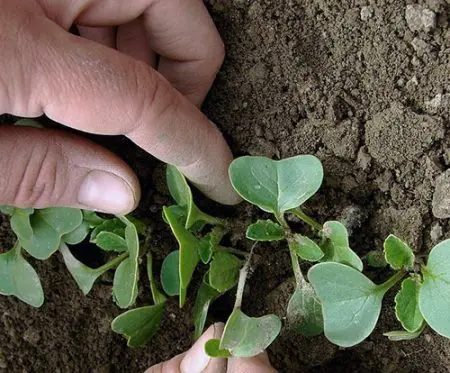
It is better to pinch off the plants, and not to pull them out, so as not to disturb the roots of the remaining ones. Young plants cannot be transferred to a new place, except perhaps with a clod of earth, so it is better to sow less often in order to lose less good sprouts.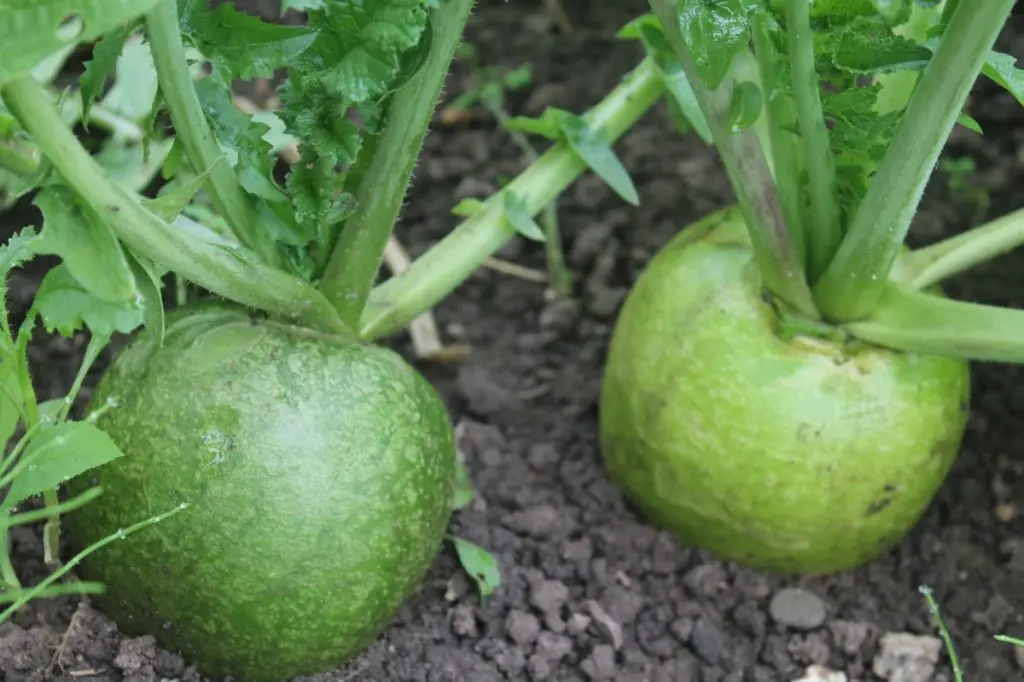
Overcrowding of plantings can lead to shooting of plants. Even without this, you need to ensure that there is air circulation inside the bed under the leaves, sunlight gets to the root crops that stick out of the ground. Yellow drying leaves should be removed along with weeds, even cut off good green leaves if they create extra shade.
Feeding
After the emergence of seedlings or after the first thinning, the bed is sprinkled with chopped wood ash. This is the first top dressing and at the same time protection from many pests. If there is a need, then it is possible to water at the stage of the beginning of the formation of root crops with a solution of nitrophoska (30 g per large bucket), usually this is limited, except that ash can still be added when the leaves turn pale.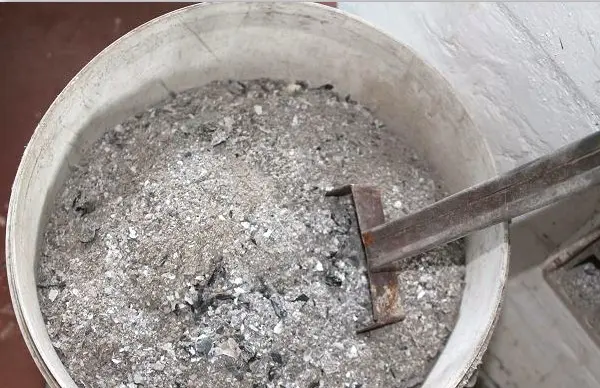
If the site was well fertilized for the previous crop, or prepared in the fall, then additional top dressing may not be needed, except on sandy or completely depleted soils.
Protection against pests
The main pests that can add to the hassle or even reduce the yield are cabbage flies, cruciferous fleas and slugs. Insects do not like ashes; periodic treatment of crops with crushed ash, tobacco dust, bitter wormwood or needles ground into flour can be a good preventive measure. You can also plant marigolds in the garden, whose smell drives away the cruciferous flea and cabbage fly. From slugs, a small ditch dug around the perimeter of the bed and filled with ash helps perfectly.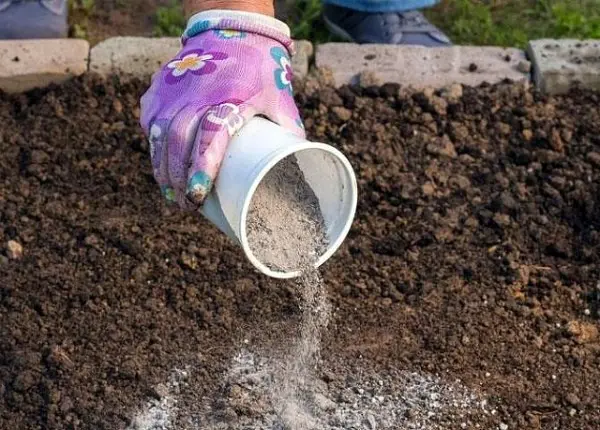
It is necessary to prevent thickening, remove excess leaves so that air can freely penetrate to the root crops, and periodically spud them, protecting the skin from coarsening, and the root crop itself from slugs.
Collection and storage
Selective harvesting of root crops will show the degree of their ripeness. In the summer, the entire crop is gradually harvested, which goes to fresh salads and is consumed immediately. But autumn harvesting is carried out in large quantities – the entire main crop is harvested simultaneously upon reaching ripeness. It is not worth leaving it in the ground – voids may appear inside the root crops. It often happens that close frosts make you harvest earlier than you would like. But it’s better to dig up the radish before frost, since it’s impossible to store frozen root crops, it’s better not to risk it.
On a fine, cool day, all root crops should be removed from the ground and left to dry for 2 to 3 hours. From light soil, you can simply pull them out with your hands, like a turnip in a fairy tale, and from dense soil you will have to take them out with a pitchfork or a shovel. After the remnants of the earth have dried up and crumbled (they can be brushed off with your hands or with a soft, dry cloth), the petioles are cut to 2–3 cm, and the crop itself is sorted. A whole intact radish can be stored in the cellar. It is carefully piled in one pile or placed in wooden or plastic boxes. For several months, it is perfectly preserved at temperatures from 0 to +2 degrees, only you have to periodically sort it out, removing perishable root crops.
Or you can put it in boxes and pour it with wet sand so that the root crops themselves do not touch. The boxes can stand in the cellar, it is desirable to moisten the sand so that the radish does not dry out. Such conditions will help to keep the harvest until spring.
Video “How to grow green radish”
From this video you will learn how to grow Margelan radish.









